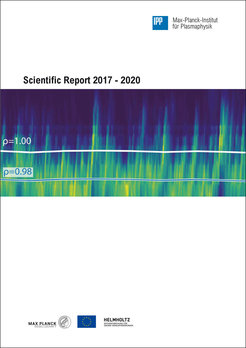IPP Scientific Report published
Overview on the scientific work of IPP from January 2017 to September 2020
On 150 pages, the Scientific Report gives an overview of IPP's research results in Garching and Greifswald, including work on the institute's six projects - ASDEX Upgrade, Wendelstein 7-X, plasma-wall interaction, collaboration on JET and ITER, and plasma theory.

A brief selection of important results: The Wendelstein 7-X stellarator initially operated with an uncooled carbon test divertor in 2017 and 2018. The experiments nevertheless delivered impressive results, such as operation at high plasma densities with plasma temperatures of more than 20 million degrees Celsius and long discharge times of up to 100 seconds. Since November 2018, Wendelstein 7-X has been undergoing an extensive upgrade to prepare it for the planned long-pulse operation. All components facing the plasma are being equipped with water cooling. After a delay due to the Covid 19 pandemic in 2020, the construction work should be completed by the end of this year.
The ASDEX Upgrade tokamak is developing the basics for ITER operation and for the design of the DEMO demonstration power plant. From 2017 to 2020, the plant – held up by the Covid 19 pandemic and a repair case – was in operation for around 20 months. The breaks were used to install additional diagnostics equipment and to complete the new electron cyclotron resonance heating system. The experiments brought great progress in the development of plasma scenarios and model development. A central topic was the development of plasmas without strong edge instabilities (edge-localised modes, or ELMs). In the meantime, ASDEX Upgrade commands a large scenario portfolio with no or only weak ELMs.
The project “Plasma-Wall Interaction” supports the experiments at the fusion devices and develops fundamental knowledge about the interaction between the hot plasma and the vessel wall in ITER, DEMO and future fusion power plants. One example is the development of tungsten-copper composites produced by means of molten copper infiltration – possibly the suitable material for heavily loaded wall parts of future fusion plants.
IPP also contributed significantly to the preparation of the third deuterium-tritium campaign planned for 2021 at the JET European Joint Experiment and worked on the development of heating systems, diagnostics and the plasma control system for ITER.
Last but not least, the theoretical areas of IPP achieved important results. For example, the mechanisms underlying the stabilising effects of fast particles were uncovered. In turbulence simulations, they strongly lower the turbulent transport in the plasma. This led to the discovery of an improved plasma state in ASDEX Upgrade and to promising predictions for Wendelstein 7-X. The origin and course of ELMs could also be explained in detail for the first time by computer simulations.
